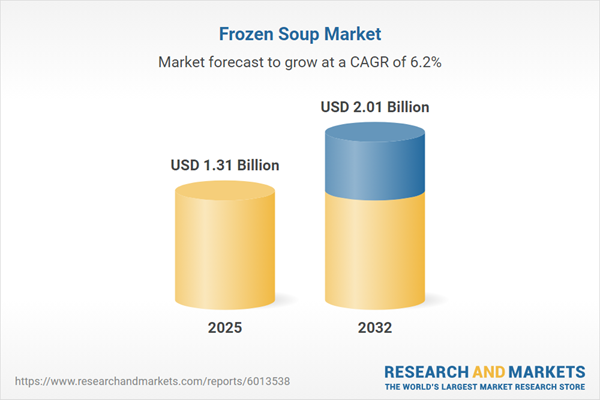Speak directly to the analyst to clarify any post sales queries you may have.
The frozen soup market is experiencing dynamic evolution, driven by shifting consumer expectations for convenience, nutrition, and sustainability. This report equips senior decision-makers with actionable insights into emerging market drivers, competitive moves, and growth priorities within the frozen soup sector.
Market Snapshot: Frozen Soup Market Size and Momentum
The Frozen Soup Market grew from USD 1.24 billion in 2024 to USD 1.31 billion in 2025. It is expected to continue growing at a CAGR of 6.19%, reaching USD 2.01 billion by 2032. The market is advancing as evolving lifestyles fuel demand for convenient, high-quality meal solutions, with innovation focused on ingredient diversity, packaging enhancements, and omnichannel distribution strategies. Stakeholders must stay ahead of these trends to secure their competitive positioning.
Scope & Segmentation
- Product Types: Beef Soup, Chicken Soup, Seafood Soup, Vegetable Soup
- Packaging Types: Cans, Pouches
- Distribution Channels: Convenience Stores, Supermarkets & Hypermarkets, Brand Platforms, eCommerce Platforms
- End-Users: Foodservice Industry, Household Consumers
- Geographic Regions: Americas (United States, Canada, Mexico, Brazil, Argentina, Chile, Colombia, Peru), Europe, Middle East & Africa (United Kingdom, Germany, France, Russia, Italy, Spain, Netherlands, Sweden, Poland, Switzerland, United Arab Emirates, Saudi Arabia, Qatar, Turkey, Israel, South Africa, Nigeria, Egypt, Kenya), Asia-Pacific (China, India, Japan, Australia, South Korea, Indonesia, Thailand, Malaysia, Singapore, Taiwan)
- Company Coverage: Amy's Kitchen, Inc., ASAHI GROUP HOLDINGS, LTD., Baxters Food Group Ltd., Blount Fine Foods, Bonduelle S.A., Conagra Brands Canada, Inc, General Mills, Inc., KETTLE CUISINE, LLC., Lidl Stiftung & Co. KG, McCain Foods Limited, Miyajima Shoyu Co.,Ltd., Nestlé SA, Phillips Foods Inc., Tabatchnick Fine Foods, The Campbell's Company, The Hain Celestial Group, Inc., The Kraft Heinz Company, The Kroger Co., Trader Joe's, Unilever Food Solutions, WK Kellogg Co
Key Takeaways: Strategic Insights for Frozen Soup Market Stakeholders
- Premiumization is influencing consumer choices, with brands differentiating through ingredient quality, novel recipes, and flavor variety.
- Health-conscious attitudes are steering portfolio expansion toward clean-label, plant-based, and nutrient-rich frozen soup options.
- Advancements in packaging—such as flexible pouches—are enhancing both sustainability credentials and consumer convenience across meal occasions.
- Technological integration in distribution channels, including e-commerce and click-and-collect, is reshaping purchasing behavior and enabling data-driven marketing.
- The foodservice sector values bulk and customizable solutions, while household consumers demand portion flexibility and ease of storage.
- Geographic expansion requires focused adaptation to regional tastes, regulatory standards, and local distribution partnerships to drive penetration in growth markets.
Tariff Impact: Navigating 2025 Supply Chain Adjustments
Recent tariff changes in the United States have increased the cost of key inputs for the frozen soup sector, driving manufacturers to reassess procurement strategies. As reliance on cost-effective global suppliers faces disruption, companies are shifting toward domestic sourcing and exploring alternative financial mechanisms to manage margin pressures. Collaboration with local partners and dynamic pricing models are enabling agile responses to evolving trade policy while supporting continued supply chain resilience.
Methodology & Data Sources
This report applies in-depth primary research, including executive interviews and buyer surveys, to capture qualitative and quantitative insights. Secondary sources encompass trade associations, regulatory filings, patent databases, and industry journals. Validation through expert advisory review and analytical modeling ensures reliable, actionable intelligence for senior leadership.
Why This Report Matters: Decision-Ready Intelligence for Leaders
- Benchmark competitive strategies and innovation in frozen soup formulations, channel execution, and sustainability practices.
- Understand region-specific market requirements and the implications of regulatory shifts to inform go-to-market decisions.
- Identify immediate and medium-term opportunities across retail, foodservice, and online channels backed by robust data analysis.
Conclusion
The frozen soup market offers diverse growth avenues across regions, segments, and channels. Leaders positioned to capture this momentum will emphasize agile supply chains, consumer-centric product development, and strategic channel activation.
Additional Product Information:
- Purchase of this report includes 1 year online access with quarterly updates.
- This report can be updated on request. Please contact our Customer Experience team using the Ask a Question widget on our website.
Table of Contents
3. Executive Summary
4. Market Overview
7. Cumulative Impact of Artificial Intelligence 2025
Companies Mentioned
The companies profiled in this Frozen Soup market report include:- Amy’s Kitchen, Inc.
- ASAHI GROUP HOLDINGS, LTD.
- Baxters Food Group Ltd.
- Blount Fine Foods
- Bonduelle S.A.
- Conagra Brands Canada, Inc
- General Mills, Inc.
- KETTLE CUISINE, LLC.
- Lidl Stiftung & Co. KG
- McCain Foods Limited
- Miyajima Shoyu Co.,Ltd.
- Nestlé SA
- Phillips Foods Inc.
- Tabatchnick Fine Foods
- The Campbell's Company
- The Hain Celestial Group, Inc.
- The Kraft Heinz Company
- The Kroger Co.
- Trader Joe’s
- Unilever Food Solutions
- WK Kellogg Co
Table Information
| Report Attribute | Details |
|---|---|
| No. of Pages | 187 |
| Published | November 2025 |
| Forecast Period | 2025 - 2032 |
| Estimated Market Value ( USD | $ 1.31 Billion |
| Forecasted Market Value ( USD | $ 2.01 Billion |
| Compound Annual Growth Rate | 6.1% |
| Regions Covered | Global |
| No. of Companies Mentioned | 22 |









